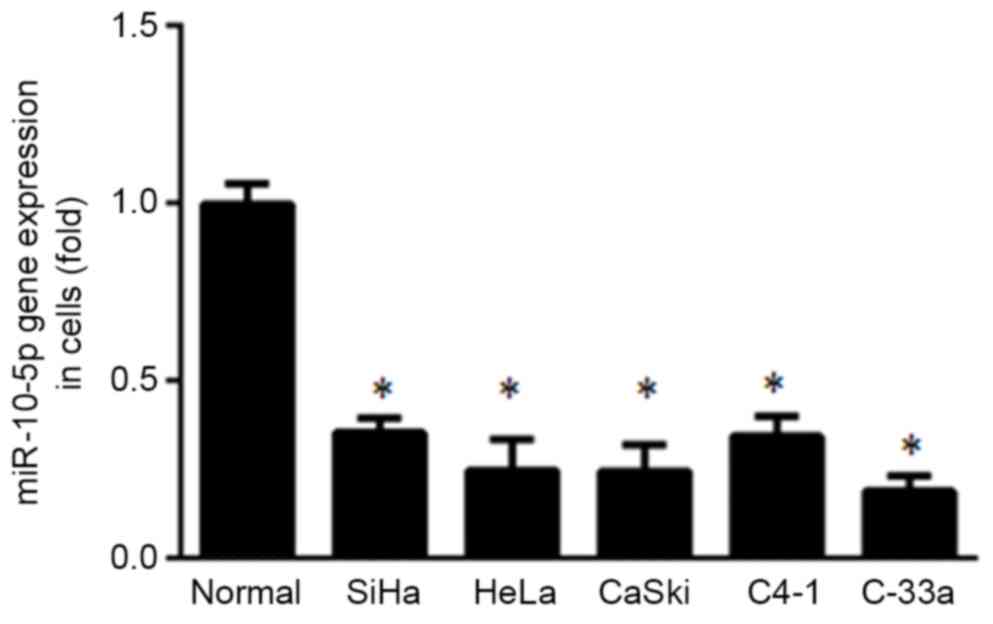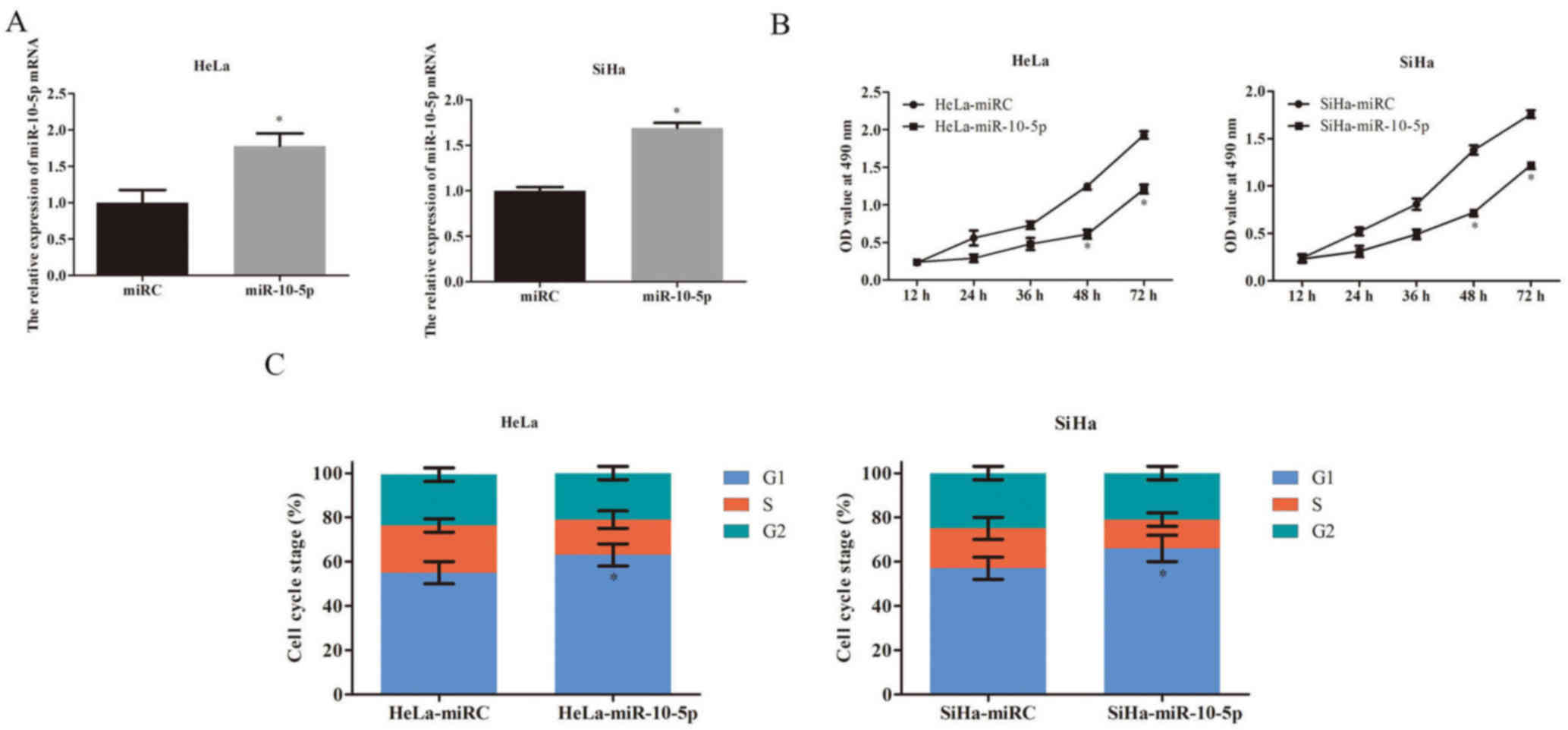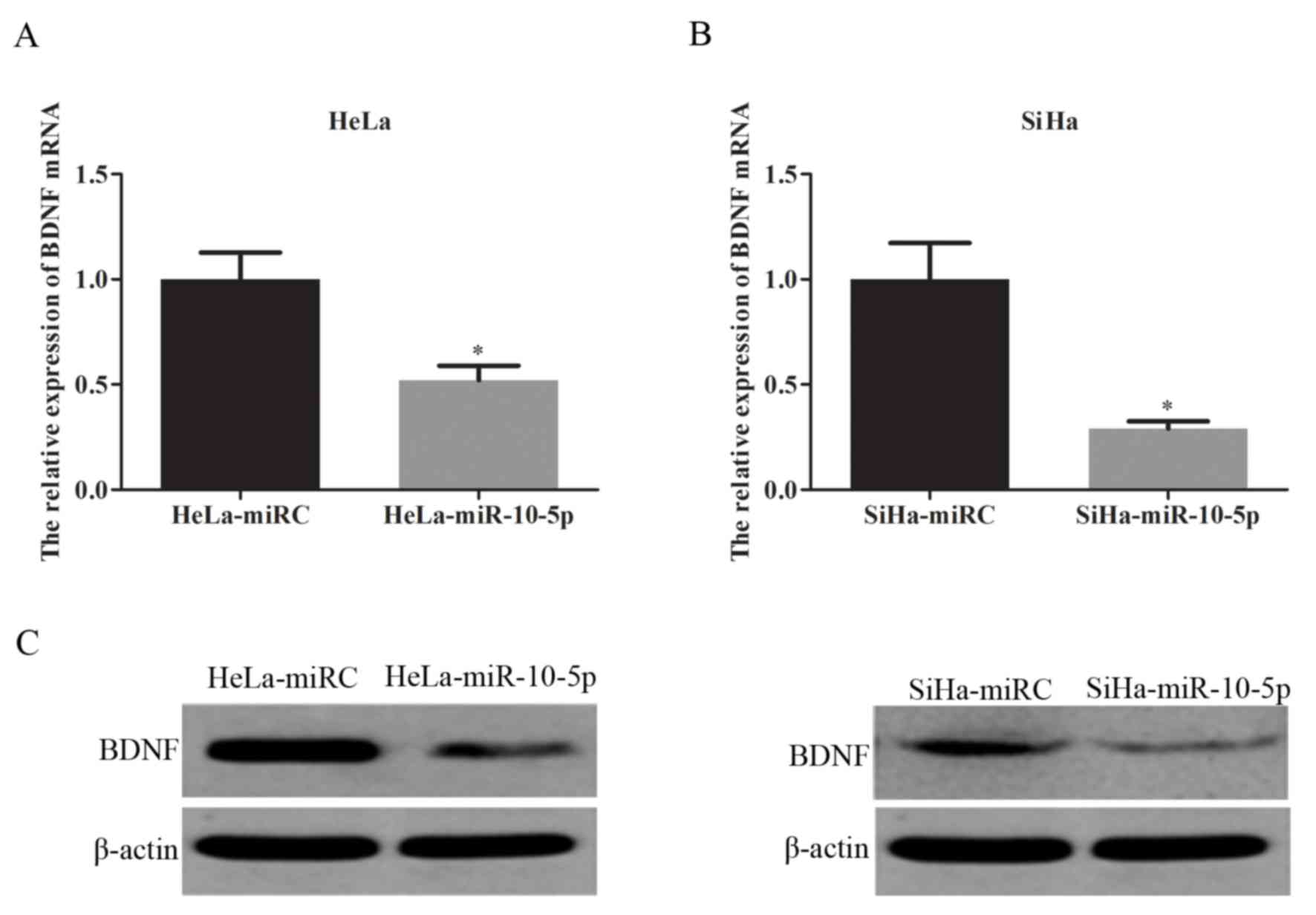|
1
|
Torre LA, Bray F, Siegel RL, Ferlay J,
Lortet-Tieulent J and Jemal A: Global cancer statistics, 2012. CA
Cancer J Clin. 65:87–108. 2015. View Article : Google Scholar : PubMed/NCBI
|
|
2
|
Nam EJ, Kim JW, Hong JW, Jang HS, Lee SY,
Jang SY, Lee DW, Kim SW, Kim JH, Kim YT, et al: Expression of the
p16INK-4a and Ki-67 in relation to the grade of cervical
intraepithelial neoplasia and high-risk human papillomavirus
infection. J Gynecol Oncol. 19:162–168. 2008. View Article : Google Scholar : PubMed/NCBI
|
|
3
|
Oluwole OP, Okoyomo OO, Onile TG, Alabi OO
and Gbejegbe JO: Cervical carcinoma, still a burden:
Histopathological analysis and review on the literature. Adv Lab
Med Int. 6:1–6. 2016.
|
|
4
|
Laukkanen P, Läärä E, Koskela P, Pukkala
E, Virkkunen H and Lehtinen M: Population fraction of cervical
neoplasia attributable to high-risk human papillomaviruses. Future
Oncol. 6:709–716. 2010. View Article : Google Scholar : PubMed/NCBI
|
|
5
|
Nilsen TW: Mechanisms of microRNA-mediated
gene regulation in animal cells. Trends Genet. 23:243–249. 2007.
View Article : Google Scholar : PubMed/NCBI
|
|
6
|
Zhang B, Pan X, Cobb GP and Anderson TA:
MicroRNAs as oncogenes and tumor suppression. Dev Biol. 302:1–12.
2007. View Article : Google Scholar : PubMed/NCBI
|
|
7
|
Liu F, Zhang S, Zhao Z, Mao X, Huang J, Wu
Z, Zheng L and Wang Q: MicroRNA-27b up-regulated by human
papillomavirus 16 E7 promotes proliferation and suppresses
apoptosis by targeting polo-like kinase2 in cervical cancer.
Oncogarget. 7:19666–19679. 2016. View Article : Google Scholar
|
|
8
|
Wang WT, Zhao YN, Yan JX, Weng MY, Wang Y,
Chen YQ and Hong SJ: Differentially expressed microRNAs in the
serum of cervical squamous cell carcinoma patients before and after
surgery. J Hematol Oncol. 7:62014. View Article : Google Scholar : PubMed/NCBI
|
|
9
|
Ma Q, Wan G, Wang S, Yang W, Zhang J and
Yao X: Serum of microRNA-205 as a novel biomarker for cervical
cancer patients. Cancer Cell Int. 14:812014. View Article : Google Scholar : PubMed/NCBI
|
|
10
|
Mi Y, Wang L, Zong L, Pei M, Lu Q and
Huang P: Genetic variants in microRNA target sites of 37 selected
cancer-related genes and the risk of cervical cancer. PLoS One.
9:e860612014. View Article : Google Scholar : PubMed/NCBI
|
|
11
|
Safan A, Seifolesiami M, Yahaghi E,
Sedaghati F and Khameneie MK: Retracted Article: Upregulation of
miR-20a and miR-10a expression levels act as potential biomarkers
of aggressive progression and poor prognosis in cervical cancer.
Tumour Biol. Oct 1–2015.(Epub ahead of print).
|
|
12
|
Zhang L, Sun J, Wang B, Ren JC, Su W and
Zhang T: MicroRNA-10b triggers the epithelial-mesenchymal
transition (EMT) of laryngeal carcinoma Hep-2 cells by directly
targeting the E-cadherin. Appl Biochem Biotechnol. 176:33–44. 2015.
View Article : Google Scholar : PubMed/NCBI
|
|
13
|
McAllister AK: Neurotrophins and neuronal
differentiation in the central nervous system. Cell Mol Life Sci.
58:1054–1060. 2001. View Article : Google Scholar : PubMed/NCBI
|
|
14
|
Cao L, Liu X, Lin EJ, Wang C, Choi EY,
Riban V, Lin B and During MJ: Environmental and genetic activation
of a brain-adipocyte BDNF/leptin axis causes cancer remission and
inhibition. Cell. 142:52–64. 2010. View Article : Google Scholar : PubMed/NCBI
|
|
15
|
Kaplan DR, Matsumoto K, Lucarelli E and
Thiele CJ: Induction of TrkB by retinoic acid mediates biologic
responsiveness to BDNF and differentiation of human neuroblastoma
cells. Eukaryotic Signal Transduction Group. Neuron. 11:321–331.
1993. View Article : Google Scholar : PubMed/NCBI
|
|
16
|
Hu Z, Shen WJ, Kraemer FB and Azhar S:
MicroRNAs 125a and 455 repress lipoprotein-supported
steroidogenesis by targeting scavenger receptor class B type I in
steroidogenic cells. Mol Cell Biol. 32:5035–5045. 2012. View Article : Google Scholar : PubMed/NCBI
|
|
17
|
Livak KJ and Schmittgen TD: Analysis of
relative gene expression data using real-time quantitative PCR and
the 2(-Delta Delta C(T)) method. Methods. 25:402–408. 2001.
View Article : Google Scholar : PubMed/NCBI
|
|
18
|
Guo D, Hou X, Zhang H, Sun W, Zhu L, Liang
J and Jiang X: More expressions of BDNF and TrkB in multiple
hepatocellular carcinoma and anti-BDNF or K252a induced apoptosis,
supressed invasion of HepG2 and HCCLM3 cells. J Exp Clin Cancer
Res. 30:972011. View Article : Google Scholar : PubMed/NCBI
|
|
19
|
Müller S: In silico analysis of regulatory
networks underlined the role of miR-10b-5p and its target BDNF in
huntington's disease. Transl Neurodegener. 3:172014. View Article : Google Scholar : PubMed/NCBI
|
|
20
|
Du X, Lin LI, Zhang L and Jiang J:
microRNA-195 inhibits the proliferation, migration and invasion of
cervical cancer cells via the inhibition of CCND2 and MYB
expression. Oncol Lett. 10:2639–2643. 2015.PubMed/NCBI
|
|
21
|
Hu Y and Liu H: MicroRNA-10a-5p and
microRNA-34c-5p in laryngeal epithelial premalignant lesions:
Differential expression and clinicopathological correlation. Eur
Arch Otorhinolaryngol. 272:391–399. 2015. View Article : Google Scholar : PubMed/NCBI
|
|
22
|
Wang X, Ling CC, Li L, Qin Y, Qi J, Liu X,
You B, Shi Y, Zhang J, Jiang Q, et al: MicroRNA-10a/10b represses a
novel target gene mib1 to regulate angiogenesis. Carrdiovasc Res.
110:140–150. 2016. View Article : Google Scholar
|
|
23
|
Stadthagen G, Tehler D, Høyland-Kroghsbo
NM, Wen J, Krogh A, Jensen KT, Santoni-Rugiu E, Engelholm LH and
Lund AH: Loss of miR-10a activates lpo and collaborates with
activated Wnt signaling in inducing intestinal neoplasia in female
mice. PLoS Genet. 9:e10039132013. View Article : Google Scholar : PubMed/NCBI
|
|
24
|
Liu X, McMruphy T, Xiao R, Slater A, Huang
W and Cao L: Hypothalamic gene transfer of BDNF inhibits breast
cancer progression and metastasis in middle age obese mice. Mol
Ther. 22:1275–1284. 2014. View Article : Google Scholar : PubMed/NCBI
|












